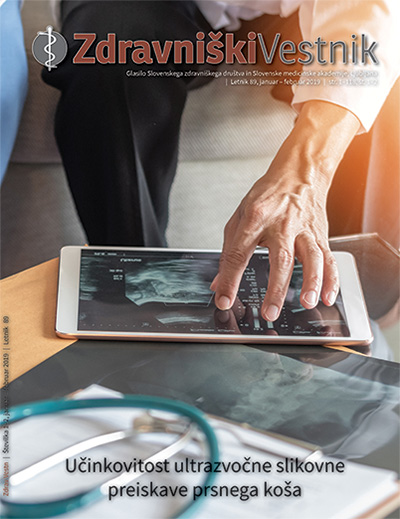Quality of work in catheterization laboratories: percutaneous coronary intervention
DOI:
https://doi.org/10.6016/ZdravVestn.2928Keywords:
catheterization laboratories, percutaneous coronary interventions, quality of workAbstract
Over the past 40 years, we have witnessed a remarkable development of interventional cardiology. The steadily increasing number of interventions in the coronary arteries quickly led to the need for a preset, structured recording of work in catheterization laboratories (CLs) and the establishment of quality control mechanisms. National societies of cardiology have established registries that allow comparison of work between regional CLs as well as at the international level. The Societies have also published a number of recommendations, the implementation of which ensures adequate quality and safety of interventions. The current paper describes various approaches to ensuring the quality of work of CLs, the recommendations of the European Society of Cardiology and a description of the relevant situation in Slovenia.
Downloads
References
1. Grüntzig A, Hirzel H, Goebel N, Gattiker R, Turina M, Myler R, et al. Percutaneous transluminal dilatation of chronic coronary stenoses. First experiences. Schweiz Med Wochenschr. 1978;108(44):1721-3.
PMID: 715409
2. Harold JG, Bass TA, Bashore TM, Brindis RG, Brush JE, Burke JA, et al.; Presidents and Staff; American College of Cardiology Foundation; American Heart Association; Society of Cardiovascular Angiography and Interventions. ACCF/AHA/SCAI 2013 update of the clinical competence statement on coronary artery interventional procedures: a report of the American College of Cardiology Foundation/American Heart Association/American College of Physicians Task Force on Clinical Competence and Training (writing committee to revise the 2007 clinical competence statement on cardiac interventional procedures). Circulation. 2013;128(4):436-72.
DOI: 10.1161/CIR.0b013e318299cd8a
PMID: 23658439
3. Bashore TM, Balter S, Barac A, Byrne JG, Cavendish JJ, Chambers CE, et al.; ACCF Task Force Members. 2012 American College of Cardiology Foundation/Society for Cardiovascular Angiography and Interventions expert consensus document on cardiac catheterization laboratory standards update: A report of the American College of Cardiology Foundation Task Force on Expert Consensus documents developed in collaboration with the Society of Thoracic Surgeons and Society for Vascular Medicine. J Am Coll Cardiol. 2012;59(24):2221-305.
DOI: 10.1016/j.jacc.2012.02.010
PMID: 22575325
4. Barbato E, Dudek D, Baumbach A, Windecker S, Haude M. Current trends in coronary interventions: an overview from the EAPCI registries. EuroIntervention. 2017;13(Z):Z8-10.
DOI: 10.4244/EIJV13IZA2
5. Banning AP, Baumbach A, Blackman D, Curzen N, Devadathan S, Fraser D, et al.; British Cardiovascular Intervention society. Percutaneous coronary intervention in the UK: recommendations for good practice 2015. Heart. 2015;101:1-13.
DOI: 10.1136/heartjnl-2015-307821
PMID: 26041756
6. Neumann FJ, Sousa-Uva M, Ahlsson A, Alfonso F, Banning AP, Benedetto U, et al.; ESC Scientific Document Group. 2018 ESC/EACTS Guidelines on myocardial revascularization. Eur Heart J. 2019;40(2):87-165.
DOI: 10.1093/eurheartj/ehy394
PMID: 30165437
7. Jacobs AK, Babb JD, Hirshfeld JW, Holmes DR; Society for Cardiovascular Angiography and Interventions. Task force 3: training in diagnostic and interventional cardiac catheterization endorsed by the Society for Cardiovascular Angiography and Interventions. J Am Coll Cardiol. 2008;51(3):355-61.
DOI: 10.1016/j.jacc.2007.11.011
PMID: 18206752
8. Di Mario C, Di Sciascio G, Dubois-Randé JL, Michels R, Mills P. Curriculum and syllabus for Interventional Cardiology subspecialty training in Europe. EuroIntervention. 2006;2(1):31-6.
PMID: 19755233
9. Dudek D, Van Belle E. Education and training committee – from curriculum to certification. EuroIntervention. 2017;13:271.
10. Serruys PW, Wijns W, Vahanian A, van Sambeek M, De Palma R. Percutaneous interventional cardiovascular medicine. S.l.: PCR Publishing; 2012.
11. Capodanno D, Buccheri S. Operator volume and mortality in percutaneous coronary intervention: a call for better competency metrics. Eur Heart J. 2018;39(18):1635-7.
DOI: 10.1093/eurheartj/ehy144
PMID: 29579187
12. Naidu SS, Aronow HD, Box LC, Duffy PL, Kolansky DM, Kupfer JM, et al. SCAI expert consensus statement: 2016 best practices in the cardiac catheterization laboratory: (Endorsed by the cardiological society of india, and sociedad Latino Americana de Cardiologia intervencionista; Affirmation of value by the Canadian Association of interventional cardiology-Association canadienne de cardiologie d’intervention). Catheter Cardiovasc Interv. 2016;88(3):407-23.
DOI: 10.1002/ccd.26551
PMID: 27137680
13. George JC, Dangas GD. Maintenance of certification in interventional cardiology revisited. JACC Cardiovasc Interv. 2010;3(4):461-2.
DOI: 10.1016/j.jcin.2010.03.001
PMID: 20398877
14. British Cardiovascular Intervention Society. Audit results 1991 to present. Lutterworth: BCIS; 1991 [cited 2014 Dec 22]. Available from: http://www.bcis.org.uk/pages/page_box_contents.asp?pageid=697&navcatid=11.
15. Pravilnik o vrstah, vsebini in poteku specializacij zdravnikov. Ur l RS. 2009(22)(42).
16. Ministrstvo za zdravje. Sklep št. 2717-18-232004 o imenovanju delovne skupine za presojo ustreznosti kvalifikacij za izvajanje posegov na koronarnem in perifernem ožilju. Ljubljana: MZ; 2017 [cited 2014 Dec 22]. Available from: http://www.mz.gov.si.
Downloads
Published
Issue
Section
License

The Author transfers to the Publisher (Slovenian Medical Association) all economic copyrights following form Article 22 of the Slovene Copyright and Related Rights Act (ZASP), including the right of reproduction, the right of distribution, the rental right, the right of public performance, the right of public transmission, the right of public communication by means of phonograms and videograms, the right of public presentation, the right of broadcasting, the right of rebroadcasting, the right of secondary broadcasting, the right of communication to the public, the right of transformation, the right of audiovisual adaptation and all other rights of the author according to ZASP.
The aforementioned rights are transferred non-exclusively, for an unlimited number of editions, for the term of the statutory
The Author can make use of his work himself or transfer subjective rights to others only after 3 months from date of first publishing in the journal Zdravniški vestnik/Slovenian Medical Journal.
The Publisher (Slovenian Medical Association) has the right to transfer the rights of acquired parties without explicit consent of the Author.
The Author consents that the Article be published under the Creative Commons BY-NC 4.0 (attribution-non-commercial) or comparable licence.



